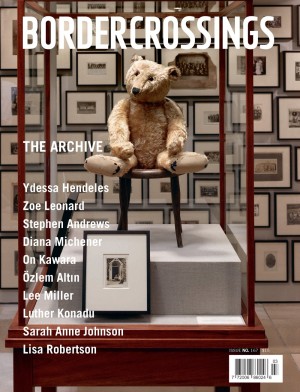Cindy Sherman
Consider, say, three of the 170-photographs included in the Cindy Sherman retrospective at MoMA this spring. Any might do, really. My choices are random selections from a massive collection spanning 30 years, delivering a right hook in terms of discipline and sustained effort alone. Whether fan or foe, the consistency and coherency of her method and vision—performance-based photography that points to the female body as object—is breathtaking. If there is cruelty to Sherman’s work, it lies in the mirror she holds up to the beloved habits of doing and representing—always twisted together—that make strap-ons of us all.

Cindy Sherman, Untitled Film Still #6, 1977, gelatin silver print, 24 x 16.5 cm. Images © the artist. Acquired through the generosity of Jo Carole and Ronald S Lauder in memory of Eugene M Schwartz. Images courtesy the Museum of Modern Art, New York.
In the “Untitled Film Stills” series, 1977–1980, for instance, her breakout work examining gendered cinematic conventions, the portrayal of women as situated objects is uncanny, legibly critical and, yes, super fun. In image after image—the complete series of 69 works hung together as compelling evidence—the power of architecture, space and the act of looking in order to take hold of, and take over, the subject is on view. In Untitled Film Still #27B, 1979, Sherman is barefoot in a hallway, still in her pajamas, mouth partly open, maybe looking our way, maybe leaning back in despair. But the walls tell equal parts of the story; rendered in two tones, dark to six feet, then white to the ceiling, they narrow, turn and literally corner her. Above her shoulder, a bucket hangs suspended—a moment of drama amid the rent and laundry. Here, gestural codes meet oppressive spatial conditions to suggest agency. And its opposite. It’s not pretty. Nor in any way reassuring, however seductive and familiar the staging.
In the “Head Shots” series, 2000–2002, a study of the actor’s essential marketing tool made in Beverly Hills—type and expressivity—take centre-stage. Whereas real-life head shots—equal parts narcissism and desire—are compulsive documents of success and beauty, Sherman, instead, presents the high-anxiety of the genre, showing a range of LA women, from a patron and hostess, resplendent in blue taffeta, to a New Age 40-something tarot card reader, in velvet and amulets. In Untitled #399, 2000, for instance, a woman with saggy breasts wears a preppy, V-necked, white cable-knit pullover with jeans, pager at the ready. Her hair is platinum, in dreadlocks. Lit to emphasize pallor and shadow, she looks directly at the camera, mouth compressed in a kind of “Oh, well—bring it” smile. It’s a thin smile, barely a grimace, and all of it remains just a bit off: breasts too big, prosthetic misplaced, the wig slightly askew. But Sherman’s eyes—the unity and repetition through so many images a strong contrast to the shifting identities—produce a big effect. Exquisitely executed, aggressively inauthentic, the work is somehow kept straight by Sherman’s eyes, direct and sincere as opposed to ironic. If type has remained a preoccupation, the “wigger” portrait points to whiteness as a category encompassing power, privilege, ugliness, loss—an appraisal of race hovering across much of her work.

Untitled #474, 2008, chromogenic colour print, 230.5 x 152.4 cm. Acquired through the generosity of an anonymous donor, Michael Lynne, Charles Heilbronn and the David Appell Family Fund.
The day I went back to the exhibition for a second look I met a collector who told me he’d “had a Cindy” but sold it. It was too hard to live with. Uh…yes. The creepiness at the core of the work—whether stemming from artifice, excess, stillness, prosthetics—compels viewers to stare down the most abject aspects of selfhood—itself a debased, corrupted category. Untitled #175, 1987, for instance, shows vomit and cake scattered over a beach towel. At top right, a pair of abandoned sunglasses reflect the image of a blond woman, mouth open in a parodic expression of anguish. Gross, yes, but this is a truly luminous photograph, technically lush and painterly in tones of blue and green. An exhibition didactic seemed to account for the darkness of the work, which shared a room with what are, for me, the nearly unbearable portraits in the sex series, noting all were made during the ’80s US Culture Wars and the AIDS epidemic. Yet the porous body—open, leaky, pimply, sick—remains astonishingly hidden within a sales culture that prizes clean shiny surfaces. Sherman imagines something different.
If feminism is about making the unseen visible, or alternately, if it involves noticing the language, structure and frames that limit real lives, Sherman is a model feminist artist. The “history portraits,” 1988–1990, recast Old Master paintings as contemporary photographs that re-present characters as types: milkmaids, noblemen, religious leaders. The fashion work (early 1980s), commissioned by outfits like Harper’s Bazaar, Rei Kawakubo, Mark Jacobs and Balenciaga, reconfigure glamour as exhaustion, dysfunction, rage. “The centrefolds,” 1981, offer up vaguely threatening scenarios but victim status is mitigated in part by her attention to the face (and expression) as the site of subjectivity. These studies take on different structures of seeing and wrestle with the conventions of representation and identity therein.
The recent “society portraits,” 2008—championed by some as “relentlessly honest” portraits of “women of a certain age”—remind me of the abiding difficulty in looking at bodies. No more about aging than the clown series is about clowns, the “society portraits” do offer shocking content: old girls. We’re here, we sneer and we come with sex drives, secrets and money. The human form—mobile, enacting, expressive, resistant—remains the richest site for consideration. But more than depicting such women as sad or freakish, the work continues Sherman’s exploration of identity as performative and the body as simultaneously repertoire and archive. ❚
“Cindy Sherman” exhibited at the Museum of Modern Art, New York, from February 26 to June 11, 2012.
MJ Thompson is a writer living in Brooklyn and Montreal. She is an assistant professor in the department of Fine Arts at Concordia University.

